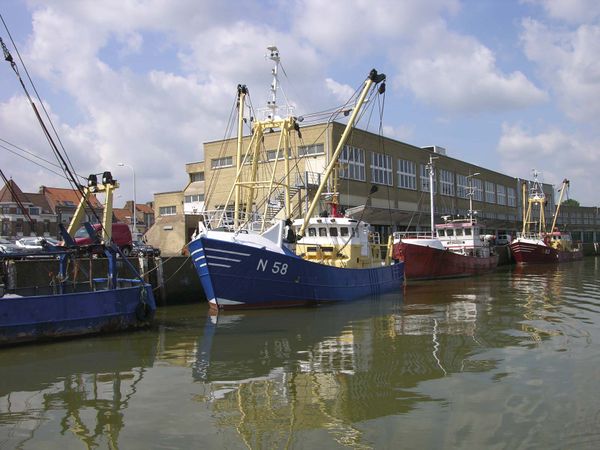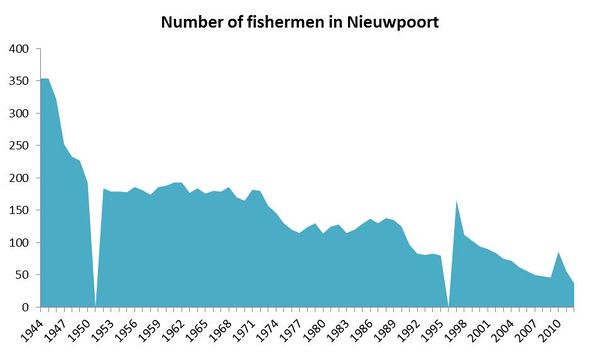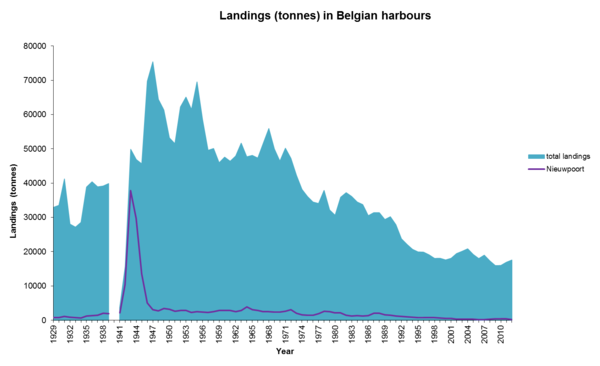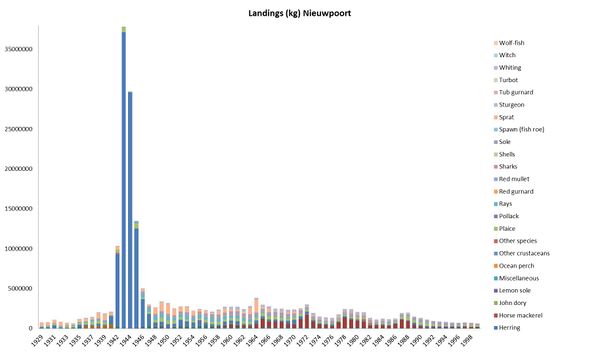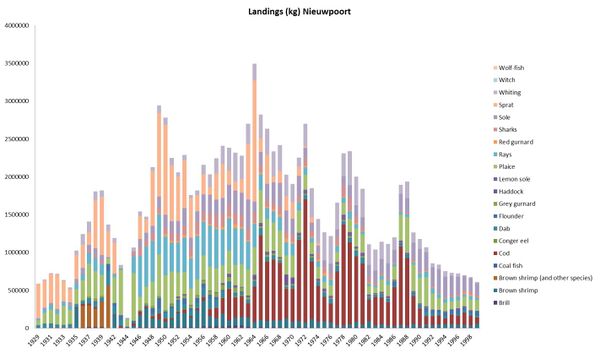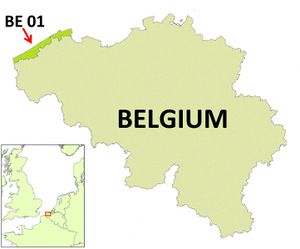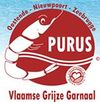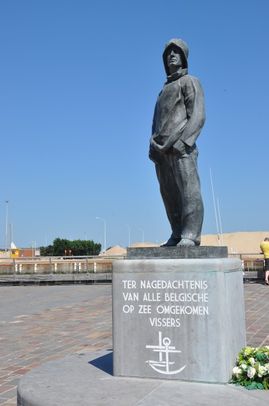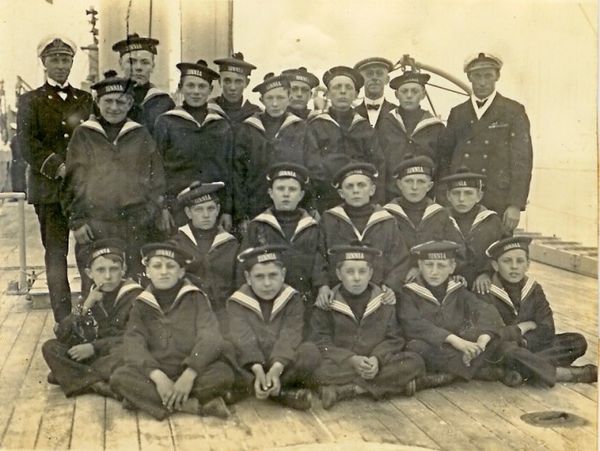Difference between revisions of "Fisheries in Nieuwpoort"
(→Fish shops and restaurants) |
(→Branding) |
||
| (67 intermediate revisions by 3 users not shown) | |||
| Line 1: | Line 1: | ||
| + | __NOTITLE__ | ||
| + | <span style="color:#3a75c4; Font-size: 130%">'''<small>Nieuwpoort</small>'''</span> | ||
| + | |||
===<span style="color:#3a75c4; Font-size: 130%">'''<small>Overview and Background</small>'''</span>=== | ===<span style="color:#3a75c4; Font-size: 130%">'''<small>Overview and Background</small>'''</span>=== | ||
---- | ---- | ||
The Belgian coast is 67 km long and is entirely bordering the province of West-Flanders (region of Flanders, Belgium). The Belgian part of the North Sea is 3,457 km<sup>2</sup> (0.5% of the North Sea area), of which more than 1/3 or 1,430 km² are territorial sea within 12 nautical miles distance of the coastline. Belgium currently has 10 coastal municipalities and 4 coastal ports (Nieuwpoort, Oostende, Zeebrugge and Blankenberge), and besides the fish auctions located in Oostende, Zeebrugge and Nieuwpoort where fish is sold according to legal procedures, there are no other dispersed landing points. Although historically the port and auction of Oostende was by far the most important, today the auctions of Zeebrugge (53%) and Oostende (45%) receive the largest share of the landings of Belgian fisheries in Belgian ports. | The Belgian coast is 67 km long and is entirely bordering the province of West-Flanders (region of Flanders, Belgium). The Belgian part of the North Sea is 3,457 km<sup>2</sup> (0.5% of the North Sea area), of which more than 1/3 or 1,430 km² are territorial sea within 12 nautical miles distance of the coastline. Belgium currently has 10 coastal municipalities and 4 coastal ports (Nieuwpoort, Oostende, Zeebrugge and Blankenberge), and besides the fish auctions located in Oostende, Zeebrugge and Nieuwpoort where fish is sold according to legal procedures, there are no other dispersed landing points. Although historically the port and auction of Oostende was by far the most important, today the auctions of Zeebrugge (53%) and Oostende (45%) receive the largest share of the landings of Belgian fisheries in Belgian ports. | ||
| − | Belgium has a minor role in the European fisheries context with 0.35% of the total EU production of fish. In 2012, the Belgian commercial sea fishing fleet counted 86 ships, with a total engine capacity of 49,135 kW and gross tonnage of 15,326 GT <ref name="Roegiers"> [http://www.vliz.be/en/imis?module=ref&refid=224957 Roegiers, B.; Platteau, J.; Van Bogaert, T.; Van Gijseghem, D.; Bekaert, K.; De Bruyne, S.; Delbare, D.; Depestele, J.; Lescrauwaet, A.-K.; Moreau, K.; Polet, H.; Robbens, J.; Vandamme, S.; Van Hoey, G.; Verschueren, B. (2013). VIRA Visserijrapport 2012 Departement Landbouw en Visserij: Brussel. 98 pp.] </ref>. 45 vessels are part of the Small Fleet Segment (max 221 kW engine power) of which 2 use passive gear. The remaining 41 vessels belong to the Large Fleet Segment and have an engine power between 221 kW and a maximum of 1,200 kW. This fleet segment represents approximately 80% of the engine power capacity and 77% of the | + | Belgium has a minor role in the European fisheries context with 0.35% of the total EU production of fish. In 2012, the Belgian commercial sea fishing fleet counted 86 ships, with a total engine capacity of 49,135 kW and gross tonnage of 15,326 Gross Tonnage (GT) <ref name="Roegiers"> [http://www.vliz.be/en/imis?module=ref&refid=224957 Roegiers, B.; Platteau, J.; Van Bogaert, T.; Van Gijseghem, D.; Bekaert, K.; De Bruyne, S.; Delbare, D.; Depestele, J.; Lescrauwaet, A.-K.; Moreau, K.; Polet, H.; Robbens, J.; Vandamme, S.; Van Hoey, G.; Verschueren, B. (2013). VIRA Visserijrapport 2012 Departement Landbouw en Visserij: Brussel. 98 pp.] </ref>. 45 vessels are part of the Small Fleet Segment (max 221 kW engine power) of which 2 use passive gear. The remaining 41 vessels belong to the Large Fleet Segment and have an engine power between 221 kW and a maximum of 1,200 kW. This fleet segment represents approximately 80% of the engine power capacity and 77% of the Gross Tonnage of the fleet. While a smaller number use trammel nets (passive gear) and otter trawl, the largest share of the Large Fleet Segment are beam trawl vessels (≥662 kW). The Belgian fleet is highly specialized: more than 68% of the effort(days at sea) and 77% of total landings are achieved by beam trawlers(2010)focusing primarily on flatfish species such as plaice (<i>Pleuronectes platessa</i>) and sole (<i>Solea solea</i>). The results of the reconstruction of the Belgian fleet dynamics since 1830 are presented in Lescrauwaet et al. 2013<ref name="LescrauwaetPhD">[http://www.vliz.be/en/imis?module=ref&refid=228661 Lescrauwaet, A.-K. (2013). Belgian fisheries: ten decades, seven seas, forty species: Historical time-series to reconstruct landings, catches, fleet and fishing areas from 1900. PhD Thesis. Ghent University (UGent): Gent. xiii, 242 pp.] </ref>. |
The number of days at sea per vessel is fixed at a maximum of 265 per year and in 2011 the entire fleet realized a fishing effort of 15,855 days at sea. In 2011, the Belgian fleet landed a total of 20,138t, of which 16,905t were landed in Belgian ports. Plaice is the most important species in terms of landed weight. The landings of 2011 represented a value of €76.3 million, 14% of which was marketed in foreign ports. Sole generates 47% of the current total value of fisheries in Belgium. The Belgian sea fisheries represent 0.04% of the national Gross Domestic Product <ref> [http://www.vliz.be/en/imis?module=ref&refid=131093 Anon. (2008). Strategische Milieubeoordeling van het Nationaal Operationeel Plan voor de Belgische visserijsector, 2007 - 2013. ILVO Visserij: Oostende. 103 pp.]</ref>. The main fishing grounds in terms of volume of landings in 2010 were in descending order: North Sea South (IVc), Eastern English Channel (VIId), North Sea Central (IVb), Southeast Ireland/Celtic Sea (VIIg) Bristol Channel (VIIf) and Irish Sea (VIIa). | The number of days at sea per vessel is fixed at a maximum of 265 per year and in 2011 the entire fleet realized a fishing effort of 15,855 days at sea. In 2011, the Belgian fleet landed a total of 20,138t, of which 16,905t were landed in Belgian ports. Plaice is the most important species in terms of landed weight. The landings of 2011 represented a value of €76.3 million, 14% of which was marketed in foreign ports. Sole generates 47% of the current total value of fisheries in Belgium. The Belgian sea fisheries represent 0.04% of the national Gross Domestic Product <ref> [http://www.vliz.be/en/imis?module=ref&refid=131093 Anon. (2008). Strategische Milieubeoordeling van het Nationaal Operationeel Plan voor de Belgische visserijsector, 2007 - 2013. ILVO Visserij: Oostende. 103 pp.]</ref>. The main fishing grounds in terms of volume of landings in 2010 were in descending order: North Sea South (IVc), Eastern English Channel (VIId), North Sea Central (IVb), Southeast Ireland/Celtic Sea (VIIg) Bristol Channel (VIIf) and Irish Sea (VIIa). | ||
| Line 15: | Line 18: | ||
<div style="margin-left:-4px>{{#display_map:51.143850, 2.740557~Fisheries in Nieuwpoort~~File:Harbor.png|type=hybrid|zoom=15|width=564|height=350}}</div> | <div style="margin-left:-4px>{{#display_map:51.143850, 2.740557~Fisheries in Nieuwpoort~~File:Harbor.png|type=hybrid|zoom=15|width=564|height=350}}</div> | ||
| − | Nieuwpoort (Geographic coordinates: 51°7′N, 2°45′E) is a town situated at the western part of the Belgian Coast and has a population of | + | Nieuwpoort (Geographic coordinates: 51°7′N, 2°45′E) is a town situated at the western part of the Belgian Coast and has a population of 11000 people. The port of Nieuwpoort is the only natural harbour of the Flemish/Belgian coast and is located at the mouth of the IJzer river. The quay walls of the fishing harbour covers an area of 400 meters and are managed by the city. Recently the city council introduced new pontoons in the fishing harbour. Those 36 meters of pontoons are especially built for the new generation polyester fishing ships. Due to tidal forces, the ships that are moored against the quay walls move along with the tides. The movements damage the fishing ships that are made out of polyester. |
The first fish auction, a wooden building, was built in 1924. In 1928, a second auction was built. During the Second World War the auction was destroyed and a new fish auction was established in 1953. In 1972 the fish auction enlarged to its current size <ref name="Beun"> [http://www.vliz.be/nl/imis?module=ref&refid=109404 Beun, J. (2011). Nieuwpoort die "Goldene Stadt". Published by the author(s): Nieuwpoort. 24 pp.]</ref>. An electronic auction system was introduced in 1999 and since 2013 there is a joint auction system between the fish auction of Nieuwpoort and Oostende-Zeebrugge. | The first fish auction, a wooden building, was built in 1924. In 1928, a second auction was built. During the Second World War the auction was destroyed and a new fish auction was established in 1953. In 1972 the fish auction enlarged to its current size <ref name="Beun"> [http://www.vliz.be/nl/imis?module=ref&refid=109404 Beun, J. (2011). Nieuwpoort die "Goldene Stadt". Published by the author(s): Nieuwpoort. 24 pp.]</ref>. An electronic auction system was introduced in 1999 and since 2013 there is a joint auction system between the fish auction of Nieuwpoort and Oostende-Zeebrugge. | ||
[[Image:Fish_auction_Nieuwpoort.jpg |center|600px|]] | [[Image:Fish_auction_Nieuwpoort.jpg |center|600px|]] | ||
| − | + | ::::Fig 1. N58 and N93 in front of the fish auction of Nieuwpoort (Source: VLIZ, Collection Daniel Moeyaert) | |
===<span style="color:#3a75c4; Font-size: 130%">'''<small>Fishing fleet</small>'''</span>=== | ===<span style="color:#3a75c4; Font-size: 130%">'''<small>Fishing fleet</small>'''</span>=== | ||
---- | ---- | ||
| − | In 2013 a total of 9 fishings vessels are registered in the port of Nieuwpoort from which 6 are defined as inshore fishing vessels: the N.58 Pelorus Jack, N.86 Rudy, [http://N.34%20L’Etaplois%20http://www.vliz.be/cijfers_beleid/zeevisserij/ship.php?id=1854 N.34 L'Etaplois], [http://www.vliz.be/cijfers_beleid/zeevisserij/photo_gallery.php?album=928&pic=24951 N.93 Aalschover], N.32 Jolly Jumper, N.79 Warrior <ref>[http://www.vliz.be/nl/imis?module=ref&refid=233432 Anon. (2014). Officiële lijst van de Belgische vissersvaartuigen = Liste officielle des navires de pêche belges. Toestand op 31 December 2013. Officiële lijst van de Belgische vissersvaartuigen = Liste officièlle des navires de pêche belges. Federale Overheidsdienst Mobiliteit en Vervoer: Brussel. | + | In 2013 a total of 9 fishings vessels are registered in the port of Nieuwpoort from which 6 are defined as inshore fishing vessels: the N.58 Pelorus Jack, N.86 Rudy, [http://N.34%20L’Etaplois%20http://www.vliz.be/cijfers_beleid/zeevisserij/ship.php?id=1854 N.34 L'Etaplois], [http://www.vliz.be/cijfers_beleid/zeevisserij/photo_gallery.php?album=928&pic=24951 N.93 Aalschover], N.32 Jolly Jumper, N.79 Warrior <ref>[http://www.vliz.be/nl/imis?module=ref&refid=233432 Anon. (2014). Officiële lijst van de Belgische vissersvaartuigen = Liste officielle des navires de pêche belges. Toestand op 31 December 2013. Officiële lijst van de Belgische vissersvaartuigen = Liste officièlle des navires de pêche belges. Federale Overheidsdienst Mobiliteit en Vervoer: Brussel. 30 pp.]</ref>. The Belgian definition of inshore fisheries ('kustvisserij') refers to vessels with an engine power of 221 kW or less (this includes any additional installed power) and a tonnage of no more than 70 GT, that make trips with a maximum period determined by the Minister (today being 48 hours) with start and end in a Belgian port. Moreover, vessels with engine power >221 kW are not allowed to fish within the 12nm which is reserved for the inshore fisheries or Small Fleet Segment ([http://codexws.vandenbroele.be/Export/1014219.html Ministerial Decree of December 16, 2005]) |
{| border="1" cellspacing="1" width="600px" | {| border="1" cellspacing="1" width="600px" | ||
| Line 31: | Line 34: | ||
! style="background:#003893"|<span style="color:white;"> Vessel name </span> | ! style="background:#003893"|<span style="color:white;"> Vessel name </span> | ||
! style="background:#003893"|<span style="color:white;"> L.O.A. in m </span> | ! style="background:#003893"|<span style="color:white;"> L.O.A. in m </span> | ||
| − | ! style="background:#003893"|<span style="color:white;"> Tonnage </span> | + | ! style="background:#003893"|<span style="color:white;"> Gros Tonnage </span> |
! style="background:#003893"|<span style="color:white;"> Year built </span> | ! style="background:#003893"|<span style="color:white;"> Year built </span> | ||
! style="background:#003893"|<span style="color:white;"> Engine power (kW) </span> | ! style="background:#003893"|<span style="color:white;"> Engine power (kW) </span> | ||
| Line 99: | Line 102: | ||
|} | |} | ||
| − | Tabel 1: Fishing Vessels of Nieuwpoort. Inshore fishing vessels are indicated in blue. ([http://www. | + | Tabel 1: Fishing Vessels of Nieuwpoort. Inshore fishing vessels are indicated in blue. ([http://www.vliz.be/nl/imis?module=ref&refid=233432 Officiële lijst van de Belgische vissersvaartuigen (Toestand op 31 december 2013)]) |
{|style="margin:10px auto" | {|style="margin:10px auto" | ||
| Line 106: | Line 109: | ||
|} | |} | ||
| − | + | Graph 1 illustrates the number of fishermen from 1944 until 2012 working in Nieuwpoort with a peak of about 350 fishermen in 1944. The number of fishermen decreased afterwards and counts at the moment about 37 fishermen. | |
| − | |||
| − | |||
| − | |||
| − | |||
| − | + | [[Image:Fishermen_N.jpg|center|600px|]] | |
| − | + | ::::::Graph.1. Number of fishermen in Nieuwpoort. ('''1944-1995''': Source: NIS and '''1997-2012''': Source: Scheepsvaartcontrole) | |
| − | |||
| − | |||
===<span style="color:#3a75c4; Font-size: 130%">'''<small>Landings</small>'''</span>=== | ===<span style="color:#3a75c4; Font-size: 130%">'''<small>Landings</small>'''</span>=== | ||
| Line 121: | Line 118: | ||
Landings and values are available from the [http://www.vliz.be/cijfers_beleid/zeevisserij/ HiFi database] from 1929 until 1999. The data from 2000-2012 that is added to the data from the HiFi database comes from the publication of [http://www.vliz.be/en/imis?module=ref&refid=227105 Tessens and Velghe (2013)]<ref>[http://www.vliz.be/nl/imis?module=ref&refid=227105 Tessens, E.; Velghe, M. (Ed.) (2013). De Belgische zeevisserij 2012: Aanvoer en besomming: Vloot, quota, vangsten, visserijmethoden en activiteit. Dienst Zeevisserij: Oostende. 119 pp.]</ref>, the landings and values of the Belgian sea fisheries in 2012. | Landings and values are available from the [http://www.vliz.be/cijfers_beleid/zeevisserij/ HiFi database] from 1929 until 1999. The data from 2000-2012 that is added to the data from the HiFi database comes from the publication of [http://www.vliz.be/en/imis?module=ref&refid=227105 Tessens and Velghe (2013)]<ref>[http://www.vliz.be/nl/imis?module=ref&refid=227105 Tessens, E.; Velghe, M. (Ed.) (2013). De Belgische zeevisserij 2012: Aanvoer en besomming: Vloot, quota, vangsten, visserijmethoden en activiteit. Dienst Zeevisserij: Oostende. 119 pp.]</ref>, the landings and values of the Belgian sea fisheries in 2012. | ||
| − | + | Graph 2 shows the total landings in Belgian harbours (blue graph) in tonnes and the landings in Nieuwpoort (purple line). The graph shows a peak of landings in 1943, around 40000 tonnes were landed in the auction of Nieuwpoort. 1943 is also the year with the highest amount of landings value (see graph 3). Graph 4 illustrates that the species that was abundantly landed in 1943 was herring. More information about herring fisheries in the southern North Sea during World War II is available in [http://www.vliz.be/nl/catalogus?module=ref&refid=228668 Lescrauwaet et al. 2013]. | |
| − | |||
| − | |||
| − | |||
| − | |||
| − | |||
| − | |||
| − | |||
| − | |||
| − | |||
| − | |||
| − | + | [[Image:Landings_T_Nieuwpoort.png|center|600px|]] | |
| + | ::::::Graph.2. Total landings (tonnes) in Nieuwpoort (1929-2012) (Source: [http://www.vliz.be/cijfers_beleid/zeevisserij/list.php HiFi database], [http://www.vliz.be/en/imis?module=ref&refid=227105 De Belgische Zeevisserij]). | ||
| + | [[Image:Values_Nieuwpoort.jpg|center|600px|]] | ||
| + | ::::::Graph.3. Value of landings (euro) in Nieuwpoort (1929-2012) (Source: [http://www.vliz.be/cijfers_beleid/zeevisserij/list.php HiFi database], [http://www.vliz.be/en/imis?module=ref&refid=227105 De Belgische Zeevisserij]). | ||
| − | + | Data of the species landed in Nieuwpoort is available from the HiFiDatabase. Graph 4 shows a selection of the most common species landed in Nieuwpoort. It is clear that during the 40’s herring was the most important species. Graph 5 excludes herring in order to give a better overview of the landed species in Nieuwpoort including sprat, whiting, cod, plaice, sole and brown shrimps. | |
| − | + | [[Image:Graph_4_Nieuwpoort.jpg|center|600px|]] | |
| + | ::::::Graph 4: Landings (kg) most important species (inclusion of herring) in Nieuwpoort (1929-1999). (Source: [http://www.vliz.be/cijfers_beleid/zeevisserij/list.php HiFi database]). | ||
| − | + | [[Image:Graph 5 Nieuwpoort.jpg|center|600px|]] | |
| + | ::::::Graph 5: Landings (kg) most important species (exclusion of herring) in Nieuwpoort (1929-1999).(Source: [http://www.vliz.be/cijfers_beleid/zeevisserij/list.php HiFi database]). | ||
| − | ===<span style="color:#3a75c4; Font-size: 130%">'''<small>Organisations</small>'''</span>=== | + | ===<span style="color:#3a75c4; Font-size: 130%">'''<small>Governance and Organisations</small>'''</span>=== |
---- | ---- | ||
| − | In Belgium, the FLAG, also called the ‘local group’, ‘Plaatselijke Groep Belgisch Zeevisserijgebied’, is a partnership between socio-economic stakeholders in the fisheries sector, NGOs and public authorities that play a crucial role in the implementation of the proposed development strategy. The lead partner of the Belgian FLAG is the Province of West Flanders. The main focus of the FLAG strategy is to add value to local fisheries products and increase local consumption. Belgian landings represent only 10% of fisheries products consumed in Belgium, leaving the remaining 90% to be met by imports. Therefore there is a considerable potential for discovering and developing local markets. It will also support diversification, innovation, the involvement of women and efforts to promote the sustainable management of the marine environment<ref>[https://webgate.ec.europa.eu/fpfis/cms/farnet/flagsheet/flag-factsheet-belgium-west-flanders FLAG factsheet - Belgium - West Flanders]</ref>. | + | In Belgium, the '''FLAG''', also called the ‘local group’, ‘Plaatselijke Groep Belgisch Zeevisserijgebied’, is a partnership between socio-economic stakeholders in the fisheries sector, NGOs and public authorities that play a crucial role in the implementation of the proposed development strategy. The lead partner of the Belgian FLAG is the Province of West Flanders. The main focus of the FLAG strategy is to add value to local fisheries products and increase local consumption. Belgian landings represent only 10% of fisheries products consumed in Belgium, leaving the remaining 90% to be met by imports. Therefore there is a considerable potential for discovering and developing local markets. It will also support diversification, innovation, the involvement of women and efforts to promote the sustainable management of the marine environment<ref>[https://webgate.ec.europa.eu/fpfis/cms/farnet/flagsheet/flag-factsheet-belgium-west-flanders FLAG factsheet - Belgium - West Flanders]</ref>. |
[[Image:FLAG.jpg|center|300px|]] | [[Image:FLAG.jpg|center|300px|]] | ||
::::::::::Fig.4. [https://webgate.ec.europa.eu/fpfis/cms/farnet/belgian-flag-factsheet Belgian FLAG area: West Flanders] | ::::::::::Fig.4. [https://webgate.ec.europa.eu/fpfis/cms/farnet/belgian-flag-factsheet Belgian FLAG area: West Flanders] | ||
| − | [[Image:Promovis.JPG| | + | [[Image:Promovis.JPG|100px|thumb|left]] |
The non-profit organization [http://www.promovis.be Promovis] Nieuwpoort was founded in 2003 by Marcel Madou (former director of the fish auction of Nieuwpoort), Ronny Beschuyt (current Director of the fish auction of Nieuwpoort) and Romeo Rau (fish merchant and chairman of Promovis) to promote inshore fisheries in Nieuwpoort as well as the fish market of Nieuwpoort <ref name="Promovis2013">Promovis (2013) Brochure Promovis 2013. 72 pp.</ref>. | The non-profit organization [http://www.promovis.be Promovis] Nieuwpoort was founded in 2003 by Marcel Madou (former director of the fish auction of Nieuwpoort), Ronny Beschuyt (current Director of the fish auction of Nieuwpoort) and Romeo Rau (fish merchant and chairman of Promovis) to promote inshore fisheries in Nieuwpoort as well as the fish market of Nieuwpoort <ref name="Promovis2013">Promovis (2013) Brochure Promovis 2013. 72 pp.</ref>. | ||
| + | The committee of Promovis is composed of persons with different expertise; the committee of 2013 consists of the former and current director of the fish auction of Nieuwpoort, a representative from the Province of West-Flanders, fish merchants and the alderman for fisheries in Nieuwpoort, mr. K. Vandecasteele. Promovis works closely with ship-owners, fishermen, the fish auction and retailers, the city of Nieuwpoort and the Province of West-Flanders<ref name="Promoviswebsite">[http://www.promovis.be/index.php www.promovis.be]</ref>. | ||
| + | |||
| − | |||
The objectives of Promovis Nieuwpoort are<ref name="Promoviswebsite"/>: | The objectives of Promovis Nieuwpoort are<ref name="Promoviswebsite"/>: | ||
* Determining the geographic and quality criteria to which fish must meet in order to receive the local quality label (Fish of Nieuwpoort) | * Determining the geographic and quality criteria to which fish must meet in order to receive the local quality label (Fish of Nieuwpoort) | ||
| Line 160: | Line 153: | ||
In addition, Promovis aims to strengthen the relationship, which is so often lacking, between the different actors. Promovis tries to strive for 'alliance' between ship-owners - fisherman – fish auction – fish traders. Each link is equally important and indispensable to create sufficient value within the fishing industry so that the industry can prosper economically and socially. | In addition, Promovis aims to strengthen the relationship, which is so often lacking, between the different actors. Promovis tries to strive for 'alliance' between ship-owners - fisherman – fish auction – fish traders. Each link is equally important and indispensable to create sufficient value within the fishing industry so that the industry can prosper economically and socially. | ||
| − | In | + | ===<span style="color:#3a75c4; Font-size: 130%">'''<small>Branding</small>'''</span>=== |
| + | ---- | ||
| + | [[Image:Purus.jpg|100px|thumb|left|link=]] | ||
| + | The Flemish brown shrimp is a typical fisheries product in Belgium. In 2006 the '''Purus label''' was introduced by a cooperation of ship owners, the cooperative Flemish fisheries organization (Cooperative Vlaamse Visserij Vereniging CVBA) to promote the Flemish unpeeled brown shrimps. The brown shrimps are caught by Belgian fishermen, the fishermen fish no longer than 24 hours and the shrimps are cooked in old Flemish manner (in sea water with salt), there are no additives, preservatives added. This all results in high quality taste. The Purus label also promotes sustainable fishing techniques<ref>[http://www.dekustkijktverder.be/index.php?id=98 De Kust kijkt verder: Purus Garnaal]</ref>. | ||
| + | |||
| + | |||
| + | [[Image:North_Sea_Life.jpg|100px|thumb|left|link=]] | ||
| + | Since 2011, the Flemish Shellfish- and fish cooperation (VSVC) supply, via an exclusive quality label, '''North Sea Life''', life brown shrimps and swimming crabs to restaurants and wholesalers. Life shrimps allows chefs to determine how they will prepare the shrimps. Life product forms the base of creative and gastronomic possibilities. The same is true for life swimming crabs. In 2013 a minimum of 200 kilo life brown shrimps were landed each day. Prices for life shrimps are on average 30 percent higher than shrimps cooked on board of the shrimp vessel<ref>[http://www.ilvo.vlaanderen.be/NL/Persenmedia/Allemedia/tabid/6294/articleType/ArticleView/articleId/1105/language/nl-NL/ILVO-ziet-in-rauwe-garnaal-meer-dan-lucratieve-niche.aspx#.UyBv6vldVSL ILVO ziet in rauwe garnaal meer dan lucratieve niche]</ref>. | ||
| + | <br style="clear:both"/> | ||
| + | |||
| + | ===<span style="color:#3a75c4; Font-size: 130%">'''<small>Fish as Food</small>'''</span>=== | ||
| + | ---- | ||
| + | The fish auction of Nieuwpoort is an important fish supplier for the several '''restaurants''' located in Nieuwpoort. A selection of the restaurants is given below. | ||
| + | |||
| + | * [http://www.bistroduport.com/ Bistro du Port] is a restaurant located near the Fish auction of Nieuwpoort, which results in a daily fresh supply of fish from the auction. | ||
| + | |||
| + | * Brasserie [http://www.tponton.be ’t Ponton] daily serves a lunch based on the fish auction’s fish supply. | ||
| + | |||
| + | * Restaurant [http://www.galjoen.be/ ‘t Vlaemsch Galjoen] is also one of the restaurants in Nieuwpoort that benefits from the nearby located fish auction. The fish supply of the auction is a source of inspiration for the restaurant owners. | ||
| + | |||
| + | * The daily supply of fish and mussels from the fish auction of Nieuwpoort is important for the Restaurant [http://www.dekrone.be/ De Krone]. The restaurant is located at the dike of Nieuwpoort. | ||
| + | |||
| + | * Also restaurant [http://www.restaurantdekogge.be/ De Kogge] selects its fish products from the supply of the fish auction of Nieuwpoort. | ||
| + | |||
| + | Next to the restaurants, there are several '''fish shops''' in Nieuwpoort. Click [https://maps.google.be/maps?ie=UTF-8&q=vishandel+nieuwpoort&fb=1&gl=be&hq=vishandel&hnear=0x47dcbb60ee3a08d1:0x40099ab2f4d5960,Nieuwpoort&ei=TGYLU6acF6Gu0QXSh4DQDw&ved=0CMYBELYD%20 here] for an overview of the fish shops in Nieuwpoort. | ||
| − | [ | + | '''Wholesalers''' of fish are located in Nieuwpoort due to the proximity of the fish auction. Amongst them [http://www.jensnv.be/ Jens nv], the fish company of Romeo Rau, chairman of Promovis. Jens nv is a wholesaler of fish that mainly delivers to restaurants. The [http://www.denieuwpoortsevistrap.be/ Nieuwpoortse Vistrap] is a wholesaler of fresh fish from the auctions of Nieuwpoort, Oostende and Zeebrugge but also from Denmark, the Netherlands and even from Iceland. Next to fresh fish, the company also sells smoked and frozen products (shellfish). Most of the time the company sells fish to restaurants and hotels located at the Belgian West coast. The company won the “[http://www.retailawards.be/ Retail-Hospitality-Award”] in 2013. |
| − | : | ||
| − | ===<span style="color:#3a75c4; Font-size: 130%">'''<small> | + | ===<span style="color:#3a75c4; Font-size: 130%">'''<small>Tourism/Education</small>'''</span>=== |
---- | ---- | ||
| − | The fish auction of Nieuwpoort is not only considered by the local council as economically important but also as a major tourist attraction for the city <ref name="Promovis2013"/>. Therefore a close cooperation exists between the department responsible for fisheries and the tourism department of the city of Nieuwpoort which also focuses on fisheries. The '''tourism department''' organizes guided visits to the fish auction, initiatives such as ‘Friday Fish Day’, a fisheries festival, fisheries weekend, ... The guided visits to the fish auction attract 10 000 visitors a year <ref>http://www.nieuwpoort.be/nieuwpoort/view/nl/nieuwpoort/toerisme</ref>. | + | The fish auction of Nieuwpoort is not only considered by the local council as economically important but also as a major tourist attraction for the city <ref name="Promovis2013"/>. Therefore a close cooperation exists between the department responsible for fisheries and the tourism department of the city of Nieuwpoort which also focuses on fisheries. The '''tourism department''' organizes guided visits to the fish auction, initiatives such as ‘Friday Fish Day’, a fisheries festival, fisheries weekend, ... The guided visits to the fish auction attract 10.000 visitors a year <ref>http://www.nieuwpoort.be/nieuwpoort/view/nl/nieuwpoort/toerisme</ref>. |
*[http://www.nieuwpoort.be/nieuwpoort/view/nl/nieuwpoort/toerisme/bezoeken/geleide_bezoeken/individuele_bezoekers/vrijdag..._visdag Friday Fish Day] | *[http://www.nieuwpoort.be/nieuwpoort/view/nl/nieuwpoort/toerisme/bezoeken/geleide_bezoeken/individuele_bezoekers/vrijdag..._visdag Friday Fish Day] | ||
| Line 176: | Line 192: | ||
* [http://www.ysara.be/nieuwpoort/view/nl/nieuwpoort/toerisme/top_navigatie/nieuws/visserijweekend Fisheries weekend] | * [http://www.ysara.be/nieuwpoort/view/nl/nieuwpoort/toerisme/top_navigatie/nieuws/visserijweekend Fisheries weekend] | ||
| − | Annually, during Whitsun, a special Fisheries weekend is held in Nieuwpoort. Numerous activities are organized with the aim of highlighting Nieuwpoort fish trade to the broad public.Some examples of activities are the North Sea shrimp peeling competition, fish dishes tasting, live performances, … On Whitsun Monday a mass is held in the fish auction buildings followed by the blessing of vessels and a floral tribute at the fishermen’s memorial. | + | Annually, during Whitsun, a special Fisheries weekend is held in Nieuwpoort. Numerous activities are organized with the aim of highlighting Nieuwpoort fish trade to the broad public. Some examples of activities are the North Sea shrimp peeling competition, fish dishes tasting, live performances, … On Whitsun Monday a mass is held in the fish auction buildings, followed by the blessing of vessels and a floral tribute at the fishermen’s memorial. |
| − | The '''fishermen’s memorial''' 'Without Words' built by sculptor de Soete in 1958 , located near the quay at the fish auction of Nieuwpoort, reminds of all Belgian fishermen killed at sea. | + | The '''fishermen’s memorial''' 'Without Words' built by sculptor de Soete in 1958, located near the quay at the fish auction of Nieuwpoort, reminds of all Belgian fishermen killed at sea. |
* Dag van de garnaal (“Shrimp day”) | * Dag van de garnaal (“Shrimp day”) | ||
| − | Annually during September, the fish auction of Nieuwpoort is dominated by the brown shrimps | + | Annually during September, the fish auction of Nieuwpoort is dominated by the brown shrimps of Nieuwpoort. During this day several activities are held inside and outside the fish auction. There is a shrimp peeling competition for children between 8 and 12 years old, shrimp cooking demonstrations, the possibility to visit the [http://www.vliz.be/cijfers_beleid/zeevisserij/photo_gallery.php?album=929&pic=32162 Z582], a shrimp vessel. Next to that a “shrimp” lunch is prepared<ref>http://www.westhoek.be/nieuws/45857/dag-van-de-garnaal-nieuwpoort Westhoek</ref>. |
{|style="margin:10px auto" | {|style="margin:10px auto" | ||
| Line 187: | Line 203: | ||
| [[Image:Dag_van_de_garnaal.jpg|center|300px]] | | [[Image:Dag_van_de_garnaal.jpg|center|300px]] | ||
|} | |} | ||
| − | + | :::Fig 6: 'Without Words', monument in Nieuwpoort ([http://www.vliz.be/en/multimedia/belgian-coast?album=4250&pic=53744 VLIZ photogallery]: Belgian coast / VLIZ (Seys, Tineke), 2012) | |
| − | + | :::Fig 7. Promotion for the ‘Shrimp Day’ in Nieuwpoort (Source: [http://www.promovis.be/index.php/evenementen Promovis]). | |
| + | |||
| + | In 1893 the “Vrije Visserijschool Nieuwpoort”, the first '''fisheries school''' of Nieuwpoort, opened its doors <ref>Smet , R., Vannecke, A. (2002). Historiek van het technisch en beroepsonderwijs, 1830-1990. Garant: Antwerpen. ISBN 90-441-1326-7. 1014 pp. </ref>. However only since 1944 the school became a fulltime day school. The fisheries school in Nieuwpoort was the smallest school in Belgium with only ten students graduating each year. The low amount of students caused the closure of the school in 1991.<ref>[http://www.vliz.be/nl/imis?module=ref&refid=45560 Visserijblad maart 1991]</ref> | ||
| + | |||
| + | [[Image:Fisheries_school_Nieuwpoort.jpg |center|600px|]] | ||
| + | ::::Fig 5. Students from the fisheries school in Nieuwpoort ([http://www.vliz.be/en/multimedia/belgian-sea-fisheries?album=1493&pic=30228 VLIZ photogallery]: Collectie Daniel Moeyaert) | ||
| + | |||
| + | ===<span style="color:#3a75c4; Font-size: 130%">'''<small>Summary</small>'''</span>=== | ||
| + | |||
| + | {{Gifs -- Harbor template | ||
| + | |vessel1=6 | ||
| + | |vessel2=3 | ||
| + | |vesseltotal=9 | ||
| + | |locationauctions=Fish auction Nieuwpoort, Kaai, 8620 Nieuwpoort | ||
| + | |FLAG=West Flanders | ||
| + | |brandlabels=The Purus label promotes the Flemish unpeeled brown shrimps.<br /> | ||
| + | Via ‘North Sea Life’ label, the Flemish Shellfish- and fish cooperation (VSVC) supply life brown shrimps and swimming crabs to restaurants and wholesalers. | ||
| + | |fishselling= Click [https://maps.google.be/maps?ie=UTF-8&q=vishandel+nieuwpoort&fb=1&gl=be&hq=vishandel&hnear=0x47dcbb60ee3a08d1:0x40099ab2f4d5960,Nieuwpoort&ei=TGYLU6acF6Gu0QXSh4DQDw&ved=0CMYBELYD%20 here] for an overview of the fish shops in Nieuwpoort. | ||
| + | |fishprocessing=[http://www.jensnv.be/ Jens nv] is a wholesaler of fish that mainly delivers to restaurants.<br /> | ||
| + | The [http://www.denieuwpoortsevistrap.be/ Nieuwpoortse Vistrap] is a wholesaler of fresh fish | ||
| + | |restaurantshotels=* [http://www.bistroduport.com/ Bistro du Port] is a restaurant located near the Fish auction of Nieuwpoort, which results in a daily fresh supply of fish from the auction. | ||
| + | * Brasserie [http://www.tponton.be ’t Ponton] daily serves a lunch based on the fish auction’s fish supply. | ||
| + | * Restaurant [http://www.galjoen.be/ ‘t Vlaemsch Galjoen] is also one of the restaurants in Nieuwpoort that benefits from the nearby located fish auction. The fish supply of the auction is a source of inspiration for the restaurant owners. | ||
| + | * The daily supply of fish and mussels from the fish auction of Nieuwpoort is important for the Restaurant [http://www.dekrone.be/ De Krone]. The restaurant is located at the dike of Nieuwpoort. | ||
| + | * Also restaurant [http://www.restaurantdekogge.be/ De Kogge] selects its fish products from the supply of the fish auction of Nieuwpoort. | ||
| + | |tourism=[http://www.nieuwpoort.be/nieuwpoort/view/nl/nieuwpoort/toerisme/bezoeken/geleide_bezoeken/individuele_bezoekers/vrijdag..._visdag Friday Fish Day]<br /> | ||
| + | [http://www.nieuwpoort.be/nieuwpoort/view/nl/nieuwpoort/toerisme/bezoeken/geleide_bezoeken/individuele_bezoekers/van_pittig_bruintje_en_grijze_garnaal “Van pittig bruintje en grijze garnaal”] | ||
| + | |festivals=[http://www.ysara.be/nieuwpoort/view/nl/nieuwpoort/toerisme/top_navigatie/nieuws/visserijweekend Fisheries weekend]<br /> | ||
| + | Dag van de garnaal (“Shrimp day”) | ||
| + | |school=The fisheries school in Nieuwpoort closed in 1991. | ||
| + | |monuments=The '''fishermen’s memorial''' 'Without Words' built by sculptor de Soete in 1958, located near the quay at the fish auction of Nieuwpoort, reminds of all Belgian fishermen killed at sea. | ||
| + | }} | ||
| + | |||
| + | '''Vessel type 1'''= In Belgium, the legal definition of inshore/coastal fleet from February 2006 onwards is all fishing vessels that have an engine power of 221 kW or less, including any additional power and a tonnage of no more than 70 GT and that undertake trips with a maximum period determined by the Minister (currently 48 hours). Vessel owners need to actively register to be included in the coastal fleet. (Source: http://www.vliz.be/imis/imis.php?module=ref&refid=210294; http://www.vliz.be/imis/imis.php?module=ref&refid=209014).<br /> | ||
| + | '''Vessel type 2'''= High sea vessels | ||
===<span style="color:#3a75c4; Font-size: 130%">'''<small>References</small>'''</span>=== | ===<span style="color:#3a75c4; Font-size: 130%">'''<small>References</small>'''</span>=== | ||
| Line 194: | Line 244: | ||
<references/> | <references/> | ||
| − | + | [[category: Background information]] | |
| + | [[category: Ports Belgium]] | ||
{{GIFS}} | {{GIFS}} | ||
Latest revision as of 11:42, 11 December 2014
Nieuwpoort
Contents
Overview and Background
The Belgian coast is 67 km long and is entirely bordering the province of West-Flanders (region of Flanders, Belgium). The Belgian part of the North Sea is 3,457 km2 (0.5% of the North Sea area), of which more than 1/3 or 1,430 km² are territorial sea within 12 nautical miles distance of the coastline. Belgium currently has 10 coastal municipalities and 4 coastal ports (Nieuwpoort, Oostende, Zeebrugge and Blankenberge), and besides the fish auctions located in Oostende, Zeebrugge and Nieuwpoort where fish is sold according to legal procedures, there are no other dispersed landing points. Although historically the port and auction of Oostende was by far the most important, today the auctions of Zeebrugge (53%) and Oostende (45%) receive the largest share of the landings of Belgian fisheries in Belgian ports.
Belgium has a minor role in the European fisheries context with 0.35% of the total EU production of fish. In 2012, the Belgian commercial sea fishing fleet counted 86 ships, with a total engine capacity of 49,135 kW and gross tonnage of 15,326 Gross Tonnage (GT) [1]. 45 vessels are part of the Small Fleet Segment (max 221 kW engine power) of which 2 use passive gear. The remaining 41 vessels belong to the Large Fleet Segment and have an engine power between 221 kW and a maximum of 1,200 kW. This fleet segment represents approximately 80% of the engine power capacity and 77% of the Gross Tonnage of the fleet. While a smaller number use trammel nets (passive gear) and otter trawl, the largest share of the Large Fleet Segment are beam trawl vessels (≥662 kW). The Belgian fleet is highly specialized: more than 68% of the effort(days at sea) and 77% of total landings are achieved by beam trawlers(2010)focusing primarily on flatfish species such as plaice (Pleuronectes platessa) and sole (Solea solea). The results of the reconstruction of the Belgian fleet dynamics since 1830 are presented in Lescrauwaet et al. 2013[2].
The number of days at sea per vessel is fixed at a maximum of 265 per year and in 2011 the entire fleet realized a fishing effort of 15,855 days at sea. In 2011, the Belgian fleet landed a total of 20,138t, of which 16,905t were landed in Belgian ports. Plaice is the most important species in terms of landed weight. The landings of 2011 represented a value of €76.3 million, 14% of which was marketed in foreign ports. Sole generates 47% of the current total value of fisheries in Belgium. The Belgian sea fisheries represent 0.04% of the national Gross Domestic Product [3]. The main fishing grounds in terms of volume of landings in 2010 were in descending order: North Sea South (IVc), Eastern English Channel (VIId), North Sea Central (IVb), Southeast Ireland/Celtic Sea (VIIg) Bristol Channel (VIIf) and Irish Sea (VIIa).
In terms of direct employment, 439 fishers are registered of which approximately 350 are of Belgian nationality. Direct employment in fisheries represent approximately 0.5% of the total employment in the Belgian coastal zone. Another 1040 persons work in the fish processing industry and another 5000 persons in associated trade and services [1]. A historical overview of Belgian sea fisheries is available from [4] and [2].
The Belgian sea fishery sector is rather small compared to that of neighbouring countries in the North Sea and has been gradually losing importance since the Second World War. It is also gradually losing importance relative to the booming tourism industry in the Belgian coastal zone. However fisheries can be an added value to the tourism experience at the coast by developing fisheries-related tourism activities [5].
Port description
Nieuwpoort (Geographic coordinates: 51°7′N, 2°45′E) is a town situated at the western part of the Belgian Coast and has a population of 11000 people. The port of Nieuwpoort is the only natural harbour of the Flemish/Belgian coast and is located at the mouth of the IJzer river. The quay walls of the fishing harbour covers an area of 400 meters and are managed by the city. Recently the city council introduced new pontoons in the fishing harbour. Those 36 meters of pontoons are especially built for the new generation polyester fishing ships. Due to tidal forces, the ships that are moored against the quay walls move along with the tides. The movements damage the fishing ships that are made out of polyester.
The first fish auction, a wooden building, was built in 1924. In 1928, a second auction was built. During the Second World War the auction was destroyed and a new fish auction was established in 1953. In 1972 the fish auction enlarged to its current size [6]. An electronic auction system was introduced in 1999 and since 2013 there is a joint auction system between the fish auction of Nieuwpoort and Oostende-Zeebrugge.
- Fig 1. N58 and N93 in front of the fish auction of Nieuwpoort (Source: VLIZ, Collection Daniel Moeyaert)
Fishing fleet
In 2013 a total of 9 fishings vessels are registered in the port of Nieuwpoort from which 6 are defined as inshore fishing vessels: the N.58 Pelorus Jack, N.86 Rudy, N.34 L'Etaplois, N.93 Aalschover, N.32 Jolly Jumper, N.79 Warrior [7]. The Belgian definition of inshore fisheries ('kustvisserij') refers to vessels with an engine power of 221 kW or less (this includes any additional installed power) and a tonnage of no more than 70 GT, that make trips with a maximum period determined by the Minister (today being 48 hours) with start and end in a Belgian port. Moreover, vessels with engine power >221 kW are not allowed to fish within the 12nm which is reserved for the inshore fisheries or Small Fleet Segment (Ministerial Decree of December 16, 2005)
| Port letters and number | Vessel name | L.O.A. in m | Gros Tonnage | Year built | Engine power (kW) |
|---|---|---|---|---|---|
| N.32 | JOLLY JUMPER | 11.78 | 21 | 2007 | 221 |
| N.34 | L'ETAPLOIS | 12.4 | 22 | 1981 | 110 |
| N.57 | SPES-NOVA | 23.75 | 99 | 1986 | 220 |
| N.58 | PELORUS JACK | 19.35 | 66 | 1986 | 221 |
| N.79 | WARRIOR | 23.82 | 70 | 1986 | 221 |
| N.86 | RUDY | 20.01 | 57 | 2006 | 220 |
| N.93 | AALSCHOVER | 21.08 | 67 | 1986 | 220 |
| N.95 | JONAS II | 12.68 | 18 | 1987 | 471 |
| N.350 | INGRID | 23.82 | 104 | 1996 | 221 |
Tabel 1: Fishing Vessels of Nieuwpoort. Inshore fishing vessels are indicated in blue. (Officiële lijst van de Belgische vissersvaartuigen (Toestand op 31 december 2013))
Graph 1 illustrates the number of fishermen from 1944 until 2012 working in Nieuwpoort with a peak of about 350 fishermen in 1944. The number of fishermen decreased afterwards and counts at the moment about 37 fishermen.
- Graph.1. Number of fishermen in Nieuwpoort. (1944-1995: Source: NIS and 1997-2012: Source: Scheepsvaartcontrole)
Landings
Landings and values are available from the HiFi database from 1929 until 1999. The data from 2000-2012 that is added to the data from the HiFi database comes from the publication of Tessens and Velghe (2013)[8], the landings and values of the Belgian sea fisheries in 2012.
Graph 2 shows the total landings in Belgian harbours (blue graph) in tonnes and the landings in Nieuwpoort (purple line). The graph shows a peak of landings in 1943, around 40000 tonnes were landed in the auction of Nieuwpoort. 1943 is also the year with the highest amount of landings value (see graph 3). Graph 4 illustrates that the species that was abundantly landed in 1943 was herring. More information about herring fisheries in the southern North Sea during World War II is available in Lescrauwaet et al. 2013.
- Graph.2. Total landings (tonnes) in Nieuwpoort (1929-2012) (Source: HiFi database, De Belgische Zeevisserij).
- Graph.3. Value of landings (euro) in Nieuwpoort (1929-2012) (Source: HiFi database, De Belgische Zeevisserij).
Data of the species landed in Nieuwpoort is available from the HiFiDatabase. Graph 4 shows a selection of the most common species landed in Nieuwpoort. It is clear that during the 40’s herring was the most important species. Graph 5 excludes herring in order to give a better overview of the landed species in Nieuwpoort including sprat, whiting, cod, plaice, sole and brown shrimps.
- Graph 4: Landings (kg) most important species (inclusion of herring) in Nieuwpoort (1929-1999). (Source: HiFi database).
- Graph 5: Landings (kg) most important species (exclusion of herring) in Nieuwpoort (1929-1999).(Source: HiFi database).
Governance and Organisations
In Belgium, the FLAG, also called the ‘local group’, ‘Plaatselijke Groep Belgisch Zeevisserijgebied’, is a partnership between socio-economic stakeholders in the fisheries sector, NGOs and public authorities that play a crucial role in the implementation of the proposed development strategy. The lead partner of the Belgian FLAG is the Province of West Flanders. The main focus of the FLAG strategy is to add value to local fisheries products and increase local consumption. Belgian landings represent only 10% of fisheries products consumed in Belgium, leaving the remaining 90% to be met by imports. Therefore there is a considerable potential for discovering and developing local markets. It will also support diversification, innovation, the involvement of women and efforts to promote the sustainable management of the marine environment[9].
The non-profit organization Promovis Nieuwpoort was founded in 2003 by Marcel Madou (former director of the fish auction of Nieuwpoort), Ronny Beschuyt (current Director of the fish auction of Nieuwpoort) and Romeo Rau (fish merchant and chairman of Promovis) to promote inshore fisheries in Nieuwpoort as well as the fish market of Nieuwpoort [10]. The committee of Promovis is composed of persons with different expertise; the committee of 2013 consists of the former and current director of the fish auction of Nieuwpoort, a representative from the Province of West-Flanders, fish merchants and the alderman for fisheries in Nieuwpoort, mr. K. Vandecasteele. Promovis works closely with ship-owners, fishermen, the fish auction and retailers, the city of Nieuwpoort and the Province of West-Flanders[11].
The objectives of Promovis Nieuwpoort are[11]:
- Determining the geographic and quality criteria to which fish must meet in order to receive the local quality label (Fish of Nieuwpoort)
- To promote the fish of Nieuwpoort as a quality product
- Support the professional/commercial fishing fleet and fish market of Nieuwpoort
- Support and promote the fishing port of Nieuwpoort as an economic, cultural, touristic and maritime unit
In addition, Promovis aims to strengthen the relationship, which is so often lacking, between the different actors. Promovis tries to strive for 'alliance' between ship-owners - fisherman – fish auction – fish traders. Each link is equally important and indispensable to create sufficient value within the fishing industry so that the industry can prosper economically and socially.
Branding
The Flemish brown shrimp is a typical fisheries product in Belgium. In 2006 the Purus label was introduced by a cooperation of ship owners, the cooperative Flemish fisheries organization (Cooperative Vlaamse Visserij Vereniging CVBA) to promote the Flemish unpeeled brown shrimps. The brown shrimps are caught by Belgian fishermen, the fishermen fish no longer than 24 hours and the shrimps are cooked in old Flemish manner (in sea water with salt), there are no additives, preservatives added. This all results in high quality taste. The Purus label also promotes sustainable fishing techniques[12].
Since 2011, the Flemish Shellfish- and fish cooperation (VSVC) supply, via an exclusive quality label, North Sea Life, life brown shrimps and swimming crabs to restaurants and wholesalers. Life shrimps allows chefs to determine how they will prepare the shrimps. Life product forms the base of creative and gastronomic possibilities. The same is true for life swimming crabs. In 2013 a minimum of 200 kilo life brown shrimps were landed each day. Prices for life shrimps are on average 30 percent higher than shrimps cooked on board of the shrimp vessel[13].
Fish as Food
The fish auction of Nieuwpoort is an important fish supplier for the several restaurants located in Nieuwpoort. A selection of the restaurants is given below.
- Bistro du Port is a restaurant located near the Fish auction of Nieuwpoort, which results in a daily fresh supply of fish from the auction.
- Brasserie ’t Ponton daily serves a lunch based on the fish auction’s fish supply.
- Restaurant ‘t Vlaemsch Galjoen is also one of the restaurants in Nieuwpoort that benefits from the nearby located fish auction. The fish supply of the auction is a source of inspiration for the restaurant owners.
- The daily supply of fish and mussels from the fish auction of Nieuwpoort is important for the Restaurant De Krone. The restaurant is located at the dike of Nieuwpoort.
- Also restaurant De Kogge selects its fish products from the supply of the fish auction of Nieuwpoort.
Next to the restaurants, there are several fish shops in Nieuwpoort. Click here for an overview of the fish shops in Nieuwpoort.
Wholesalers of fish are located in Nieuwpoort due to the proximity of the fish auction. Amongst them Jens nv, the fish company of Romeo Rau, chairman of Promovis. Jens nv is a wholesaler of fish that mainly delivers to restaurants. The Nieuwpoortse Vistrap is a wholesaler of fresh fish from the auctions of Nieuwpoort, Oostende and Zeebrugge but also from Denmark, the Netherlands and even from Iceland. Next to fresh fish, the company also sells smoked and frozen products (shellfish). Most of the time the company sells fish to restaurants and hotels located at the Belgian West coast. The company won the “Retail-Hospitality-Award” in 2013.
Tourism/Education
The fish auction of Nieuwpoort is not only considered by the local council as economically important but also as a major tourist attraction for the city [10]. Therefore a close cooperation exists between the department responsible for fisheries and the tourism department of the city of Nieuwpoort which also focuses on fisheries. The tourism department organizes guided visits to the fish auction, initiatives such as ‘Friday Fish Day’, a fisheries festival, fisheries weekend, ... The guided visits to the fish auction attract 10.000 visitors a year [14].
The fish auction of Nieuwpoort organizes series of guided visits to the fish auction on Fridays. This event is organized with the support of the City of Nieuwpoort and the province of West-Flanders, the Palm Breweries (Rodenbach) and the cooperation of skipper and crew of the "Endlich", an unique sailboat which forms the symbol of Nieuwpoort.
This is a guided visit to the fish auction and the fishing port of Nieuwpoort. Afterwards there is a degustation of North Sea shrimp and local beer ‘Rodenbach’.
Annually, during Whitsun, a special Fisheries weekend is held in Nieuwpoort. Numerous activities are organized with the aim of highlighting Nieuwpoort fish trade to the broad public. Some examples of activities are the North Sea shrimp peeling competition, fish dishes tasting, live performances, … On Whitsun Monday a mass is held in the fish auction buildings, followed by the blessing of vessels and a floral tribute at the fishermen’s memorial.
The fishermen’s memorial 'Without Words' built by sculptor de Soete in 1958, located near the quay at the fish auction of Nieuwpoort, reminds of all Belgian fishermen killed at sea.
- Dag van de garnaal (“Shrimp day”)
Annually during September, the fish auction of Nieuwpoort is dominated by the brown shrimps of Nieuwpoort. During this day several activities are held inside and outside the fish auction. There is a shrimp peeling competition for children between 8 and 12 years old, shrimp cooking demonstrations, the possibility to visit the Z582, a shrimp vessel. Next to that a “shrimp” lunch is prepared[15].
- Fig 6: 'Without Words', monument in Nieuwpoort (VLIZ photogallery: Belgian coast / VLIZ (Seys, Tineke), 2012)
- Fig 7. Promotion for the ‘Shrimp Day’ in Nieuwpoort (Source: Promovis).
In 1893 the “Vrije Visserijschool Nieuwpoort”, the first fisheries school of Nieuwpoort, opened its doors [16]. However only since 1944 the school became a fulltime day school. The fisheries school in Nieuwpoort was the smallest school in Belgium with only ten students graduating each year. The low amount of students caused the closure of the school in 1991.[17]
- Fig 5. Students from the fisheries school in Nieuwpoort (VLIZ photogallery: Collectie Daniel Moeyaert)
Summary
| Background information | |||
|---|---|---|---|
| Fishing Fleet | Vessel type 1 | 6 | |
| Fishing Fleet | Vessel type 2 | 3 | |
| Fishing Fleet | Vessel type 3 | ||
| Fishing Fleet | Vessels total | 9 | |
| Landings | Total Landings (tonnes) | Demersal (tonnes) | |
| Landings | Total Landings (tonnes) | Pelagic (tonnes) | |
| Landings | Total Landings (tonnes) | Shellfish (tonnes) | |
| Landings | Total Landings (tonnes) | Main species (tonnes) | |
| Landings | Total Landings (tonnes) | All species (tonnes) | |
| Landings | Values | Demersal | |
| Landings | Values | Pelagic | |
| Landings | Values | Shellfish | |
| Landings | Values | All species | |
| Landings | Number of fishermen | Number of fishermen (Regular) | |
| Landings | Number of fishermen | Number of fishermen (Part-time) | |
| Landings | Number of fishermen | Number of fishermen Total | |
| Landings | Major fish species | ||
| Landings | Landing points | ||
| Landings | Location of auctions | Fish auction Nieuwpoort, Kaai, 8620 Nieuwpoort | |
| Governance and organisation | Governance | ||
| Governance and organisation | FLAG | West Flanders | |
| Governance and organisation | Location of fishermen's organisations | ||
| Branding | Brand labels | The Purus label promotes the Flemish unpeeled brown shrimps. Via ‘North Sea Life’ label, the Flemish Shellfish- and fish cooperation (VSVC) supply life brown shrimps and swimming crabs to restaurants and wholesalers. | |
| Fish as food | Fish selling | Click here for an overview of the fish shops in Nieuwpoort. | |
| Fish as food | Fish processing | Jens nv is a wholesaler of fish that mainly delivers to restaurants. The Nieuwpoortse Vistrap is a wholesaler of fresh fish | |
| Fish as food | Restaurants/hotels |
| |
| Tourism & Education | Tourism & Fishing | Friday Fish Day | |
| Tourism & Education | Festivals | Fisheries weekend Dag van de garnaal (“Shrimp day”) | |
| Tourism & Education | Fishing museums | ||
| Tourism & Education | Aquariums | ||
| Tourism & Education | Monuments | The fishermen’s memorial 'Without Words' built by sculptor de Soete in 1958, located near the quay at the fish auction of Nieuwpoort, reminds of all Belgian fishermen killed at sea. | |
| Tourism&Education | Fishing training School | The fisheries school in Nieuwpoort closed in 1991. | |
Vessel type 1= In Belgium, the legal definition of inshore/coastal fleet from February 2006 onwards is all fishing vessels that have an engine power of 221 kW or less, including any additional power and a tonnage of no more than 70 GT and that undertake trips with a maximum period determined by the Minister (currently 48 hours). Vessel owners need to actively register to be included in the coastal fleet. (Source: http://www.vliz.be/imis/imis.php?module=ref&refid=210294; http://www.vliz.be/imis/imis.php?module=ref&refid=209014).
Vessel type 2= High sea vessels
References
- ↑ 1.0 1.1 Roegiers, B.; Platteau, J.; Van Bogaert, T.; Van Gijseghem, D.; Bekaert, K.; De Bruyne, S.; Delbare, D.; Depestele, J.; Lescrauwaet, A.-K.; Moreau, K.; Polet, H.; Robbens, J.; Vandamme, S.; Van Hoey, G.; Verschueren, B. (2013). VIRA Visserijrapport 2012 Departement Landbouw en Visserij: Brussel. 98 pp.
- ↑ 2.0 2.1 Lescrauwaet, A.-K. (2013). Belgian fisheries: ten decades, seven seas, forty species: Historical time-series to reconstruct landings, catches, fleet and fishing areas from 1900. PhD Thesis. Ghent University (UGent): Gent. xiii, 242 pp.
- ↑ Anon. (2008). Strategische Milieubeoordeling van het Nationaal Operationeel Plan voor de Belgische visserijsector, 2007 - 2013. ILVO Visserij: Oostende. 103 pp.
- ↑ Lescrauwaet, A.-K.; Debergh, H.; Vincx, M.; Mees, J. (2010). Fishing in the past: Historical data on sea fisheries landings in Belgium. Mar. Policy 34(6): 1279-1289. dx.doi.org/10.1016/j.marpol.2010.05.006
- ↑ Anon. (2011). Europees Visserijfonds (EVF). AS 4: ontwikkelingsstrategie voor het Belgisch kustgebied. Europees Visserijfonds: (s.l.). 33 pp.
- ↑ Beun, J. (2011). Nieuwpoort die "Goldene Stadt". Published by the author(s): Nieuwpoort. 24 pp.
- ↑ Anon. (2014). Officiële lijst van de Belgische vissersvaartuigen = Liste officielle des navires de pêche belges. Toestand op 31 December 2013. Officiële lijst van de Belgische vissersvaartuigen = Liste officièlle des navires de pêche belges. Federale Overheidsdienst Mobiliteit en Vervoer: Brussel. 30 pp.
- ↑ Tessens, E.; Velghe, M. (Ed.) (2013). De Belgische zeevisserij 2012: Aanvoer en besomming: Vloot, quota, vangsten, visserijmethoden en activiteit. Dienst Zeevisserij: Oostende. 119 pp.
- ↑ FLAG factsheet - Belgium - West Flanders
- ↑ 10.0 10.1 Promovis (2013) Brochure Promovis 2013. 72 pp.
- ↑ 11.0 11.1 www.promovis.be
- ↑ De Kust kijkt verder: Purus Garnaal
- ↑ ILVO ziet in rauwe garnaal meer dan lucratieve niche
- ↑ http://www.nieuwpoort.be/nieuwpoort/view/nl/nieuwpoort/toerisme
- ↑ http://www.westhoek.be/nieuws/45857/dag-van-de-garnaal-nieuwpoort Westhoek
- ↑ Smet , R., Vannecke, A. (2002). Historiek van het technisch en beroepsonderwijs, 1830-1990. Garant: Antwerpen. ISBN 90-441-1326-7. 1014 pp.
- ↑ Visserijblad maart 1991
